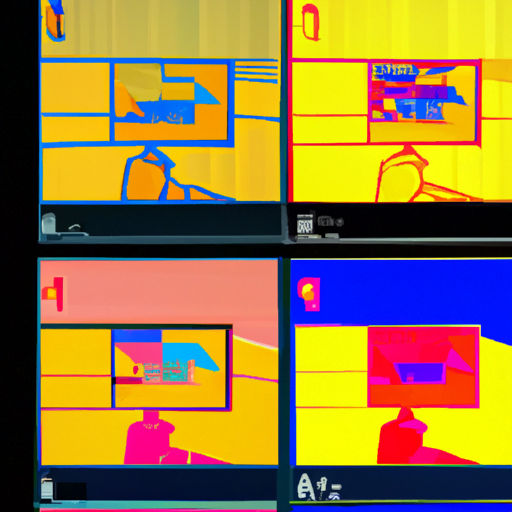
-
Table of Contents
- Designing AI-Generated Interactive Maps and Visualizations
- The Power of AI in Map Design
- The Design Process for AI-Generated Maps
- Data Collection and Preparation
- Algorithm Selection
- Training the AI Model
- Map Generation and Visualization
- User Testing and Feedback
- Real-World Examples
- COVID-19 Tracking
- Transportation Planning
- Environmental Monitoring
- Benefits of AI-Generated Interactive Maps
- Summary
Designing AI-Generated Interactive Maps and Visualizations

Artificial Intelligence (AI) has revolutionized various industries, and one area where it has made significant advancements is in the creation of interactive maps and visualizations. AI-powered tools can now generate dynamic and engaging maps that provide valuable insights and enhance user experiences. In this article, we will explore the process of designing AI-generated interactive maps and visualizations, the benefits they offer, and some real-world examples of their applications.
The Power of AI in Map Design
AI technology has opened up new possibilities in map design by automating complex tasks and enabling the creation of interactive and visually appealing maps. Here are some key reasons why AI is transforming the field:
- Efficiency: AI algorithms can process large datasets and generate maps at a much faster pace than traditional manual methods. This allows designers to focus more on analysis and interpretation rather than spending time on repetitive tasks.
- Data Analysis: AI can analyze vast amounts of geospatial data and extract meaningful patterns and insights. This helps in creating maps that effectively communicate complex information.
- Personalization: AI algorithms can adapt to user preferences and behavior, allowing for personalized map experiences. This enhances user engagement and satisfaction.
- Automation: AI can automate the process of updating maps in real-time based on changing data inputs. This ensures that maps are always up-to-date and relevant.
The Design Process for AI-Generated Maps
Designing AI-generated interactive maps involves a systematic process that combines human creativity with AI capabilities. Here are the key steps in the design process:
Data Collection and Preparation
The first step is to gather relevant data for the map. This can include geospatial data, demographic information, or any other data that is relevant to the purpose of the map. The data should be cleaned and prepared to ensure accuracy and consistency.
Algorithm Selection
Next, the appropriate AI algorithm needs to be selected based on the specific requirements of the map. There are various AI techniques that can be used, such as machine learning, deep learning, or computer vision. The choice of algorithm depends on factors like the complexity of the data, desired level of interactivity, and the type of insights to be derived.
Training the AI Model
The selected AI algorithm needs to be trained using the prepared data. This involves feeding the algorithm with labeled examples to learn patterns and relationships within the data. The training process helps the AI model understand how to generate maps that align with the desired outcomes.
Map Generation and Visualization
Once the AI model is trained, it can generate maps based on the input data. The generated maps can be further enhanced with interactive elements like tooltips, zooming, or filtering options. Visualization techniques such as color coding, heatmaps, or 3D representations can be applied to make the maps more visually appealing and informative.
User Testing and Feedback
After the initial map design is complete, it is crucial to conduct user testing to gather feedback and identify areas for improvement. User feedback helps in refining the map design and ensuring that it meets the needs and expectations of the target audience.
Real-World Examples
Let’s explore some real-world examples where AI-generated interactive maps and visualizations have been successfully implemented:
COVID-19 Tracking
During the COVID-19 pandemic, AI-powered maps have played a crucial role in tracking the spread of the virus. These maps provide real-time updates on the number of cases, deaths, and recoveries at a global, national, and local level. Users can interact with the maps to explore trends, view hotspots, and access relevant information.
Transportation Planning
AI-generated maps are being used in transportation planning to optimize routes, predict traffic congestion, and improve public transportation systems. These maps consider various factors like traffic volume, historical data, and real-time information to provide accurate and efficient navigation options.
Environmental Monitoring
AI-powered maps are helping in monitoring and managing environmental resources. For example, satellite imagery combined with AI algorithms can detect deforestation patterns, identify endangered species habitats, and track changes in land use. These maps assist in making informed decisions for conservation and sustainable development.
Benefits of AI-Generated Interactive Maps
The use of AI-generated interactive maps and visualizations offers several benefits:
- Enhanced Decision-Making: AI-powered maps provide valuable insights and enable data-driven decision-making. They help users understand complex information quickly and make informed choices.
- Improved User Engagement: Interactive elements in AI-generated maps enhance user engagement and encourage exploration. Users can interact with the maps, customize views, and gain a deeper understanding of the data.
- Efficiency and Time Savings: AI automates the map generation process, saving time and effort for designers. This allows them to focus on higher-level tasks like analysis and interpretation.
- Real-Time Updates: AI algorithms can update maps in real-time based on changing data inputs. This ensures that the maps are always up-to-date and relevant.
Summary
AI-generated interactive maps and visualizations have transformed the way we design and interact with maps. The power of AI in map design lies in its ability to process large datasets, analyze complex information, and personalize user experiences. By automating repetitive tasks and providing valuable insights, AI empowers designers to create visually appealing and informative maps. Real-world examples in various domains demonstrate the effectiveness of AI-generated maps in tracking COVID-19, optimizing transportation, and monitoring the environment. The benefits of AI-generated interactive maps include enhanced decision-making, improved user engagement, time savings, and real-time updates. As AI technology continues to advance, we can expect even more innovative and impactful applications in the field of map design.
